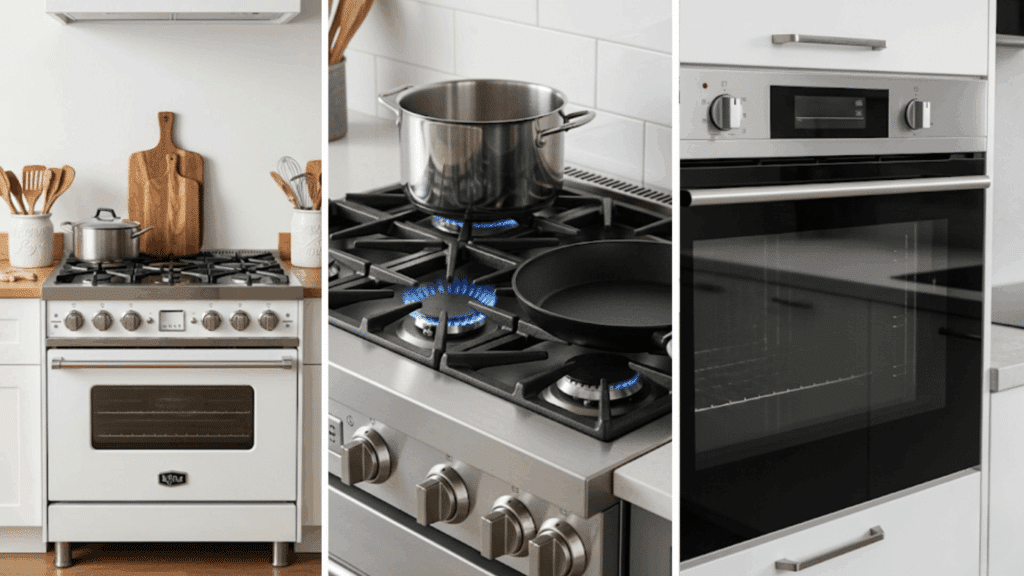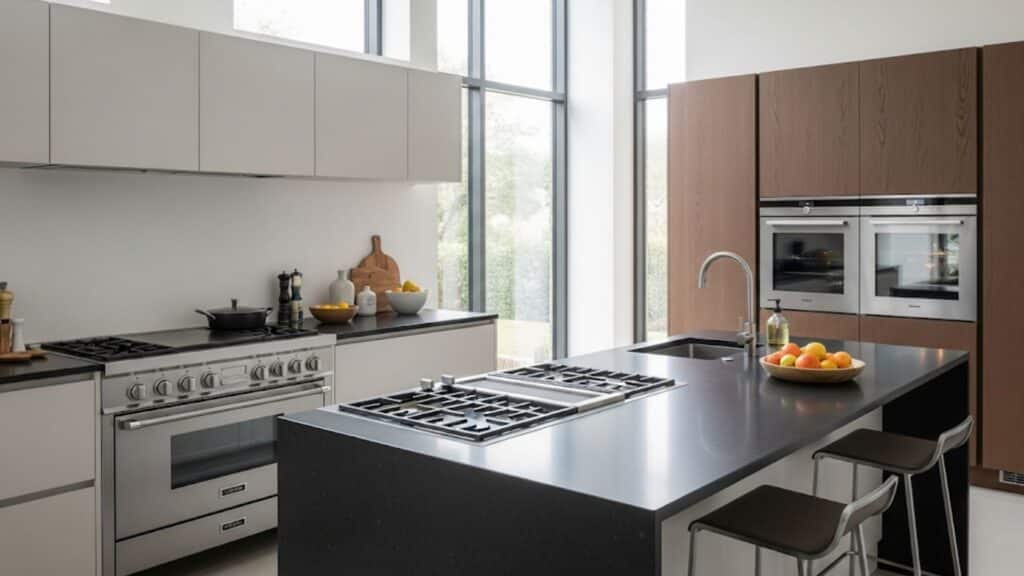Have you ever asked yourself what a range in a kitchen is and why it’s important for your cooking setup? Knowing this helps you figure out what appliance suits your space and cooking style best.
Some kitchens need appliances that combine multiple functions, while others prefer separate units for more control.
I’ll help you pick the right option, which can make your kitchen work smarter, not harder. It’s about choosing convenience and space-saving without losing cooking power.
Every kitchen and cook is different, so understanding your choices lets you prepare meals with ease and enjoyment. Ready to find your perfect fit? Let’s jump into the details.
What is a Range in a Kitchen?
A range is a kitchen appliance that combines a stovetop (also called a cooktop) and an oven into one unit. It lets you cook food on burners and bake or roast in the oven below.
This differs from a standalone oven, which is separate and only used for baking or roasting. Similarly, a cooktop is just the flat surface with burners for cooking, without an oven.
People often say “stove” when they really mean “range” because it’s a more familiar term. But technically, a stove was an older term for a heating device, while a range includes both cooking parts.
Range vs. Stove vs. Oven: Key Differences

I find that knowing the differences between these three cooking appliances helps you make better kitchen decisions.
While stoves focus on surface cooking, ovens handle baking and roasting, and ranges combine both functions in one unit, here’s what sets each apart:
1. Stove
A stove usually means the cooking surface with burners or heating elements on top for pots and pans. Originally, stoves were heating devices fueled by wood or coal to warm homes.
Today, the word “stove” often refers to the cooktop area of the kitchen appliance or the whole unit. It is mainly used for cooking food on the surface by boiling, frying, or simmering. Unlike a range, a stove by itself does not include an oven for baking.
2. Oven
An oven is a closed, heated space designed for baking, roasting, or broiling food. It may be a standalone appliance or part of a kitchen range. Ovens use gas or electricity and cook food by surrounding it with heat.
They often feature convection fans to cook food evenly. Ovens focus only on cooking inside the enclosed chamber and do not have burners or a cooktop above.
3. Range
A kitchen range is a single appliance that combines both a stovetop and an oven. It lets you cook food on burners above and bake or roast inside below. Ranges are popular because they save space and offer all-in-one convenience.
They can run on gas, electricity, or both. Many homes use ranges as the main cooking appliance due to their versatility and efficiency.
Types of Kitchen Ranges
I find that each range type offers different benefits depending on your cooking style and kitchen setup. Choosing the right one can make a big difference in how much you enjoy cooking at home.
Here’s how the main types compare:
| Type | Description | Pros | Cons |
|---|---|---|---|
| Gas Range | Uses open flame burners for cooking | Precise heat control, quick temperature changes | Needs a gas line, harder to clean |
| Electric Range | Uses a coil or smooth glass cooktop | Even heating, easier cleaning | Slower heat response, less control |
| Dual-Fuel | Gas cooktop with electric oven | Best of both worlds, versatile cooking | More expensive, needs two hookups |
| Induction | Uses magnetic heating with special pans | Fast heating, energy efficient, safe | Requires compatible cookware, costlier |
I’ve noticed that most people pick based on what utilities they already have and their budget. The key is matching the range type to how you actually cook and what features matter most to you.
Standard Kitchen Range Sizes and Dimensions
Standard kitchen ranges usually come in three common widths: 30 inches, 36 inches, and 48 inches. The height typically measures about 36 inches to match countertop height, and the depth ranges from 25 to 27 inches.
Before buying, measure the space between cabinets, front to back, and floor to countertop for a proper fit.
Small kitchens benefit from 30-inch ranges to save space, while large kitchens can accommodate 36-inch or 48-inch models for extra burners and cooking area.
Proper measuring ensures the range fits well with cabinets and counters, enabling a comfortable and safe kitchen workflow without overcrowding.
Upsides and Downsides of Using Range in a Kitchen
Here’s a simple way to understand the pros and cons of using a kitchen range. The comparison below makes everything much easier to follow:
| Category | Upsides | Downsides |
| Space & Design | Saves space by combining two appliances into one unit. | Less flexible, as the oven’s location is fixed below the cooktop. |
| Cost & Value | More cost-effective than buying separate units. | Difficult to upgrade or replace just one part of the appliance. |
| Installation & Convenience | Simple to install, often only needing one hookup. | Can have a limited oven capacity compared to a dedicated wall oven. |
| Functionality | Streamlined workflow with cooktop and oven in one place. | A major malfunction in one part requires replacing the whole unit, which can be costly. |
This explanation gives you a clearer view of why ranges are useful, but also the possible drawbacks you should consider.
Choosing Between a Range and Separate Appliances

A range is a great pick for small kitchens where space is tight, budget is important, or simple cooking is the goal.
People looking for more luxury or those who bake a lot often choose separate wall ovens and cooktops for added flexibility.
In a compact apartment, a range fits easily and frees up counter space. For a large kitchen with custom cabinets, separate appliances make sense and offer more options.
Open-plan kitchens with islands often use wall ovens with separate cooktops for easy workflow.
Making the right choice depends on the size, budget, and cooking style, according to appliance experts and verified guides.
Key Things to Check Before Buying a Range
When shopping for a range, certain features can make your cooking experience much better and safer. Focusing on the right details helps you pick an appliance that actually fits your lifestyle. Here are the key features to look for:
- Look for the number of burners or cooking elements to match your cooking needs and family size.
- Choose convection ovens for faster, even baking or standard ovens for simpler cooking.
- Consider smart technology like app control or timers that make cooking easier and more precise.
- Self-cleaning ovens save time by using heat or steam to clean without scrubbing.
- Safety features such as child locks and auto shut-off help prevent accidents in busy kitchens.
Making a list of which features matter most to you before shopping helps avoid getting distracted by fancy extras.
Popular Range Brands and Models
Here’s a quick breakdown of some popular models, their features, and estimated costs so you can compare easily:
| Brand & Model | Main Features | Estimated Cost |
|---|---|---|
| Thermador Pro Grand 36″ | Star burners, Home Connect smart tech, extra-low simmer | $6,500 – $10,000 |
| Samsung NX58H9500WS | 5 burners, convection oven, Wi-Fi controls | $1,200 – $1,600 |
| KitchenAid KSGB900ESS | 5 burners, EVEN-HEAT convection, baking drawer | $2,300 – $3,000 |
| Air frying, convection, edge-to-edge cooktop, Wi-Fi enabled | $2,000 – $2,600 | |
| Bosch 800 Series HGI8056UC | Meat probe, convection oven, self-clean, quiet operation | $2,600 – $3,200 |
This makes it easier to see which brand matches your budget. You can now choose based on both cost and features.
Final Thoughts
Now that you understand what a range is in a kitchen and how it fits different needs, I’m here to help you make smarter choices.
If you want simplicity or more control, the right setup improves your cooking life every day. It all depends on your kitchen size, cooking habits, and budget. The perfect setup is just a decision away, making cooking easier and more enjoyable.
If you have thoughts or questions about your cooking space or appliance choice, please feel free to share your kitchen stories or doubts in the comments below.














